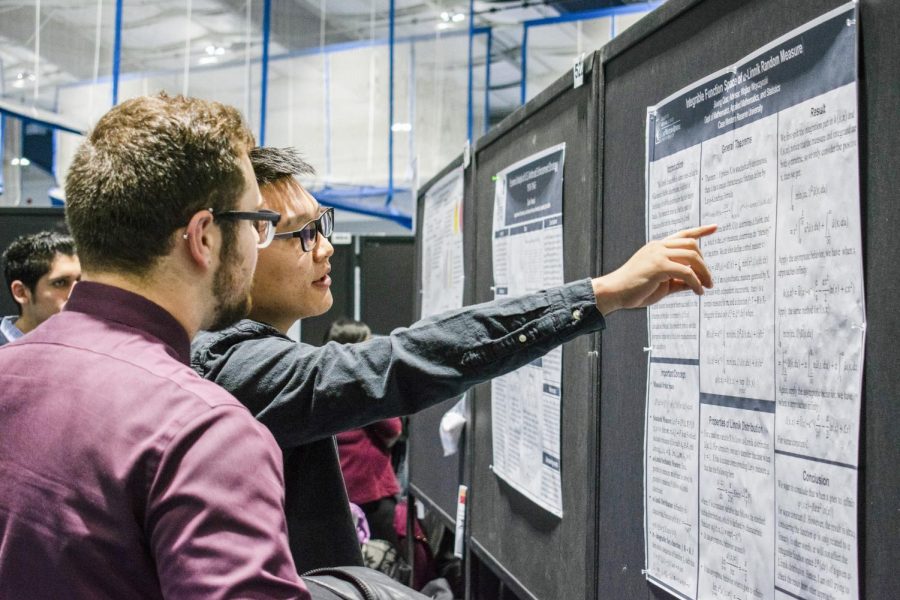Research ShowCASE brings together community of researchers
Attendants at the Research ShowCASE model virutal reality goggles. The annual event offers researchers the opportunity to present their work and explain findings to the campus and surrounding community.
On Friday, April 20, Case Western Reserve University held its highly anticipated Research ShowCASE, a day-long event showcasing the wide variety of research, technological development and creative and intellectual activities which occur on campus.
This year’s ShowCASE was the largest to date, featuring a keynote speaker, live demonstrations of presenters’ research and technology, judging and awards submissions and more.
The event took place in the Veale Convocation, Recreation and Athletic Center, where hundreds of posters from undergraduate and graduate students, faculty, staff, alumni, business and industry leaders and other community members were displayed for the community to view.
Tucked away in the back corner, for instance, was a booth featuring Microsoft’s HoloLens technology. Its researchers were beta-testing software which will, in coming years, be used to train medical school students.
Groups of attendees also had the opportunity to test out augmented reality goggles and experience a full-scale, interactive, virtual human body right in front of their eyes.
Lining the walls were booths with engaging, and often interactive, displays and presentations. To one side of the court were exhibits displaying robotics technology, faculty and staff research, virtual reality demonstrations and more. Filling up the entire inside of the track were rows of posters that participants and visitors busily walked through.
Over half the presenters at ShowCASE were undergraduate students. Many CWRU students showcased the results of their Seminar Approach to General Education and Scholarship Capstone projects, which usually span over the course of a semester or year.
For example, over the course of a semester, two fourth-year mechanical engineering students, Jasmine Heusey and William Dorow, worked with a nearby urban farm which was developing an energy-efficient heating system for the greenhouse.
When asked what he hoped to get out of presenting at ShowCASE, Dorow, “We want to spread awareness for the community greenhouse partners. [They] are a really good charity; they have a really good mission.”
Spreading the word about community research partners is just one of the many goals the organizers of the conference hoped to achieve.
“Our biggest goal is [for ShowCASE to be] an educational opportunity,” said Tracy Wilson-Holden, executive director for Research Integrity, Education and Outreach in the University’s Office of Research Administration. “[Presenting research] is a vital skill for all of the students to have as they go through their careers, and so it’s so important to have the opportunity to practice, and this is [a] safe environment to practice.
Wilson-Holden is one of the main organizers of the Research ShowCASE, and has been involved with the event for six years.
“I think we’re always looking to do something new and different each year,” she said. “This year, we had a ‘girls in STEM’ kind of theme. Our keynote speaker was a woman in STEM, we did a SAGES Future Scholars Lecture, which was by Alexis Abramson, [another] woman in STEM.”
The keynote was delivered by soprano singer and neuroscientist Indre Viskontas, who discussed motivation, goal-setting and creativity in both academics and life in general. Viskontas’s speech encompassed the ‘women in STEM’ theme, and illustrated the interdisciplinary nature of research at CWRU.
According to organizers of the event, displaying so much wide-ranging research is an arduous task.
“[Planning ShowCASE] is a long process, and it involves a lot of people,” said JC Scharf-Deering, director of Conflict of Interests in the Office of Research and Compliance. “We are 100 percent funded by sponsors, so we couldn’t without the sponsors; but it takes a village, and it takes almost a year.”
Despite the rigorous planning process, Scharf-Deering appreciates the outcome of this event.
“They just ‘wow’ me all the time,” she said on the research students’ presentations.
According to various students, the opportunity to present their work, complete or incomplete, provided experience which taught them many valuable lessons and skills.
First-year student Jiongcheng Lou said, “It has been a really good experience. As we present more and more, we get better and better.”
He added, “Last year, during my overnight visit, I came to Research ShowCASE, and this year it’s as big, if not bigger, than last year’s event.”
Research ShowCASE provided a platform for presenters to share their work and gain experience. An interactive mobile app can be accessed for those who missed the event and would like to view abstracts, schedules, floor layout and more.
Yugan is a third year student studying philosophy and physics. He writes about concerts, albums, and the intersection of art forms.


